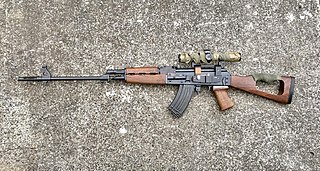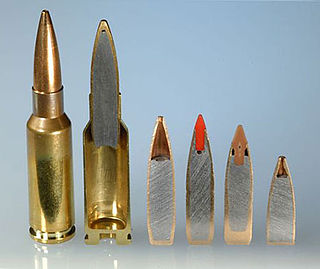
A carbine is a long gun that has a barrel shortened from its original length. Most modern carbines are rifles that are compact versions of a longer rifle or are rifles chambered for less powerful cartridges.

The AK-74 is an assault rifle designed by small arms designer Mikhail Kalashnikov in 1974. While primarily associated with the Soviet Union, it has been used by many countries since the 1970s. It is chambered for the 5.45×39mm cartridge, which replaced the 7.62×39mm cartridge of Kalashnikov's earlier automatic weapons for the Soviet Armed Forces.
The RPK, sometimes retroactively termed the RPK-47, is a Soviet 7.62×39mm light machine gun that was developed by Mikhail Kalashnikov in the early 1960s, in parallel with the AKM assault rifle. It was created to standardize the small arms inventory of the Soviet Army, where it replaced the 7.62×39mm RPD machine gun. The RPK continues to be used by the military of the post-Soviet states and certain African and Asian nations. The RPK is also manufactured in Bulgaria, Hungary, Romania, and Serbia.

The Tabuk Sniper Rifle is an Iraqi semi-automatic designated marksman rifle, made from a modified version of the Zastava M70 assault rifle. The Tabuk Rifle was manufactured at the Al-Qadissiya Establishments in Iraq using machinery sold to Iraq by Zastava Arms of Yugoslavia when Saddam Hussein was president.

The two most common assault rifles in the world are the Soviet AK-47 and the American M16. These Cold War-era rifles have been used in conflicts both large and small since the 1960s. They are used by military, police, security forces, revolutionaries, terrorists, criminals, and civilians alike and will most likely continue to be used for decades to come. As a result, they have been the subject of countless comparisons and endless debate.

The OTs-14-4 "Groza-4" is a Russian selective fire bullpup assault rifle chambered for the 9×39mm subsonic cartridge. It was developed in the 1990s at the TsKIB SOO in Tula, Russia.

The Zastava M85 is a carbine designed and produced by then Yugoslavian Zastava Arms. It is a shortened version of the original rifle, the Zastava M80, which is itself successor to the Zastava M70 assault rifle. The M85 is practically same as the carbine version of the M70, the Zastava M92, the only difference being in caliber, and in this case, the magazine design, as same as with original rifles, the M70 and M80.

The 6.5mm Grendel is an intermediate cartridge jointly designed by British-American armorer Bill Alexander, competitive shooter Arne Brennan and Lapua ballistician Janne Pohjoispää, as a low-recoil, high-precision rifle cartridge specifically for the AR-15 platform at medium/long range. It is an improved variation of the 6.5mm PPC.

The Zastava M21 is a series of 5.56×45mm NATO rifles developed and manufactured by Zastava Arms in Serbia.

Zastava Arms is a Serbian manufacturer of firearms and artillery, based in Kragujevac, Serbia. In 1853, it was founded, and cast its first cannon. It is the leading producer of firearms in Serbia and is a large contributor to the local defense industry. Zastava Arms produces and exports a wide variety of products to over forty countries, including the Zastava M70, a Kalashnikov rifle.

The Zastava M90 is an assault rifle developed and produced by Zastava Arms in Serbia. It was developed from the Zastava M70 assault rifle, a modified copy of the Soviet AKM, but with a Western type flash eliminator added on the barrel end, chambered in the Western 5.56×45mm NATO caliber, and with a different magazine design, similar to a STANAG magazine.
The Zastava M70 is a 7.62×39mm assault rifle. Developed in the Socialist Federal Republic of Yugoslavia by Zastava Arms during the 1960s, the M70 was an unlicensed derivative of the Soviet AK-47. Due to political differences between the Soviet Union and Yugoslavia at the time, namely the latter's refusal to join the Warsaw Pact, Zastava was unable to directly obtain the technical specifications for the AK and opted to reverse engineer the weapon type. Although the M70 was functionally identical to the AK, it had unique in-built features that better enabled it to fire rifle grenades. These included a thicker receiver, a new latch for the dust cover to ensure it wouldn't be jarred loose by a grenade discharge, and a folding grenade sight bracket over the rifle's gas block, which also shut off the gas system when raised.

The Zastava M72 is a light machine gun developed and manufactured by then Yugoslav Zastava Arms company. The M72 was patterned after the Soviet RPK light machine gun.

The Zastava M77 B1 is a battle rifle developed and manufactured by Zastava Arms in Serbia. It was introduced in 1977. It is a derivative of the Zastava M70 and modified copy of the Soviet AKM chambered in 7.62×51mm with an enlarged receiver, and a Western-style flash suppressor. It is gas-operated, air-cooled, magazine-fed, selective fire battle rifle with a fixed wooden stock. The M77 AB1 has a folding stock. Early versions had a milled receiver and an adjustable gas block with flip up rifle grenade sights.

An intermediate cartridge is a rifle/carbine cartridge that has significantly greater power than a pistol cartridge but still has a reduced muzzle energy compared to fully powered cartridges, and therefore is regarded as being "intermediate" between traditional rifle and handgun cartridges.

The AKM is an assault rifle designed by Soviet small arms designer Mikhail Kalashnikov in 1959. It was developed as the successor to the AK-47 adopted by the USSR a decade prior.

An assault rifle is a select fire rifle that uses an intermediate-rifle cartridge and a detachable magazine. Assault rifles were first put into mass production and accepted into widespread service during World War II. The first assault rifle to see major usage was the German StG 44, a development of the earlier Mkb 42. While immediately after World War II, NATO countries were equipped with battle rifles, the development of the M16 rifle during the Vietnam War prompted the adoption of assault rifles by the rest of NATO. By the end of the 20th century, assault rifles had become the standard weapon in most of the world's armies, replacing full-powered rifles and submachine guns in most roles. The two most successful modern assault rifles are the AK-47 and the M16 designs and their derivatives.

The 7.62×39mm round is a rimless bottlenecked intermediate cartridge of Soviet origin. The cartridge is widely used due to the worldwide proliferation of Russian SKS and AK-47 pattern rifles, as well as RPD and RPK light machine guns.
The Zastava PAP are a series of Serbian sporting rifles based on the Zastava M70 and Zastava M77B1. They are nearly identical to their military counterparts, but lack select-fire capability and have been modified with a number of sporting features designed to comply with firearms imports laws in the United States, where they are primarily marketed.

















